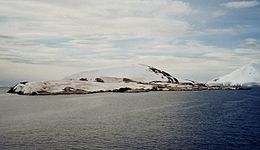Petermann Island
 Petermann Island from a distance | |
| Geography | |
|---|---|
| Location | Antarctica |
| Coordinates | 65°10′S 64°10′W / 65.167°S 64.167°W |
| Length | 2 km (1.2 mi) |
| Administration | |
| Administered under the Antarctic Treaty System | |
| Demographics | |
| Population | 0 |
Petermann Island is a small, low and rounded island, lying off the northwest coast of Kyiv Peninsula in Graham Land, Antarctica, a short distance south of Booth Island and the Lemaire Channel. It is a popular tourist destination.
Description
The island is 1.8 km (1.1 mi) long and 1.2 km (0.75 mi) across. It rises steeply to elevations of up to 250 m (820 ft) from a rocky coastline with raised pebble beaches. It has volcanic origins, with about half the land surface covered by a permanent, crevassed icecap. Ice-free areas have a sparse vegetation of mosses and lichens.[1] The bedrock of the island is granodiorite,[2]
History
The island was discovered by a
Huts built by the expedition are gone, although a
Geography

A large number of locations on the island have been individually charted and named. Unless otherwise specified, the following features were first charted by the French Antarctic Expedition during their winter on the island, and named by Captain Jean-Baptiste Charcot.
Rouch Point forms the northwest end of Petermann Island. It was named for Jules Rouch, the expedition's oceanographer.[3] Godfroy Point marks the northern extremity of the island. It was named by Captain Charcot for Rene Godfroy, sub-lieutenant on the Pourquoi-Pas.[4] Liouville Point marks the northeast end of the island. It was named for J. Liouville, the expedition's zoologist.[5]
Depeaux Point forms the south end of the island.
Also on the south end of the island is Megalestris Hill, a rocky hill approximately 35 m (115 ft) high. It was named Megalestris after an obsolete generic name for the
Important Bird Area

The island has been identified as an Important Bird Area (IBA) by BirdLife International because it supports a breeding colony of about 3,000 pairs of gentoo penguins. Other birds nesting at the site in smaller numbers include Adélie penguins, imperial shags, Wilson's storm petrels and south polar skuas.[1]
Groussac Refuge
Groussac Refuge | |
|---|---|
Refuge | |
 Naval refuge Groussac in 2013 | |
| Country | |
| Location in Antarctic Peninsula | Petermann Island Graham Land Antarctica |
| Administered by | Argentine Navy |
| Established | 1955 |
| Named for | Paul Groussac |
| Type | Seasonal |
| Status | Operational |
Groussac Refuge (65°10′33″S 64°08′10″W / 65.175727°S 64.136247°W) is an Argentine naval refuge (originally called
See also
- List of Antarctic and sub-Antarctic islands
- List of Antarctic field camps
References
- ^ a b "Petermann Island". BirdLife data zone: Important Bird Areas. BirdLife International. 2013. Retrieved 2013-01-14.
- ISBN 978-3-642-23462-0.
- ^ "Rouch Point". Geographic Names Information System. United States Geological Survey, United States Department of the Interior. Retrieved 2020-05-04.
- ^ "Godfroy Point". Geographic Names Information System. United States Geological Survey. Retrieved 2020-05-04.
- ^ "Liouville Point". Geographic Names Information System. United States Geological Survey. Retrieved 2020-05-04.
- ^ "Depeaux Point". Geographic Names Information System. United States Geological Survey. Retrieved 2020-05-04.
- ^ "Port Circumcision". Geographic Names Information System. United States Geological Survey. Retrieved 2020-05-04.
- ^ "Megalestris Hill". Geographic Names Information System. United States Geological Survey. Retrieved 2020-05-04.
- ^ "List of Historic Sites and Monuments approved by the ATCM (2012)" (PDF). Antarctic Treaty Secretariat. 2012. Retrieved 2013-10-28.


